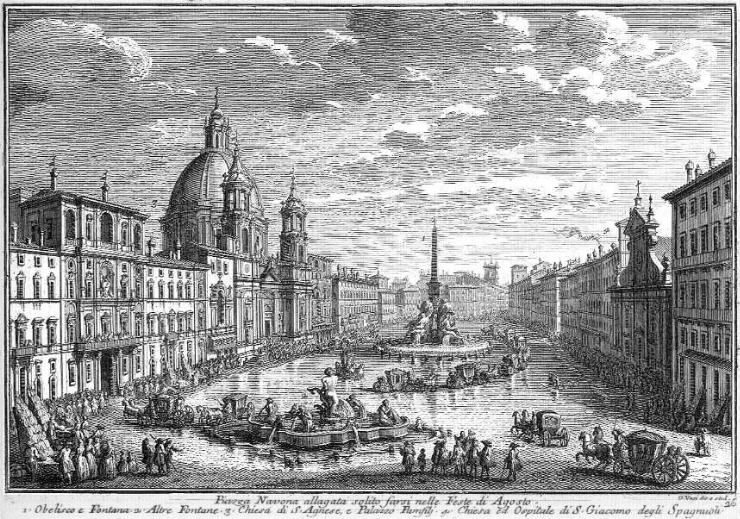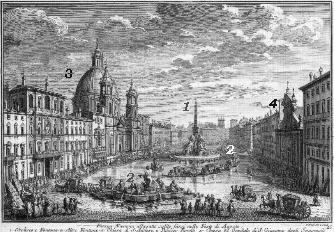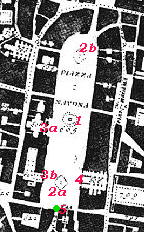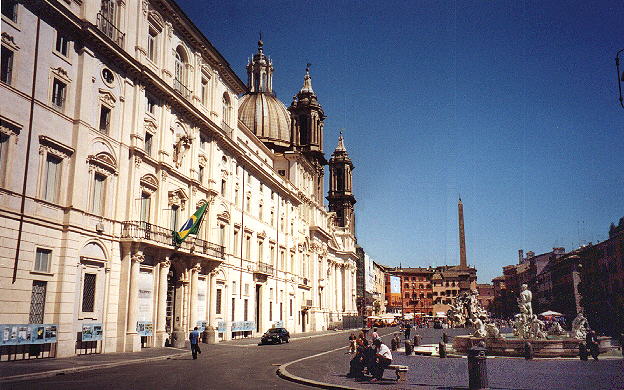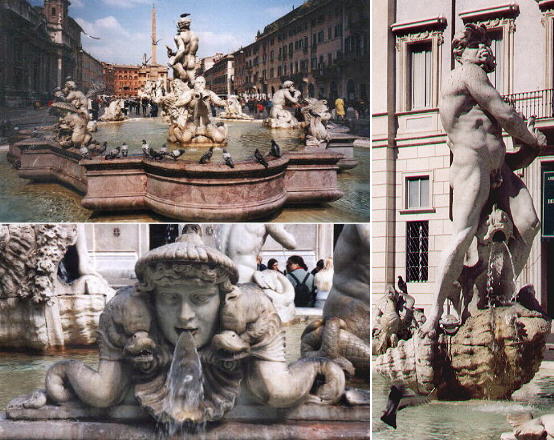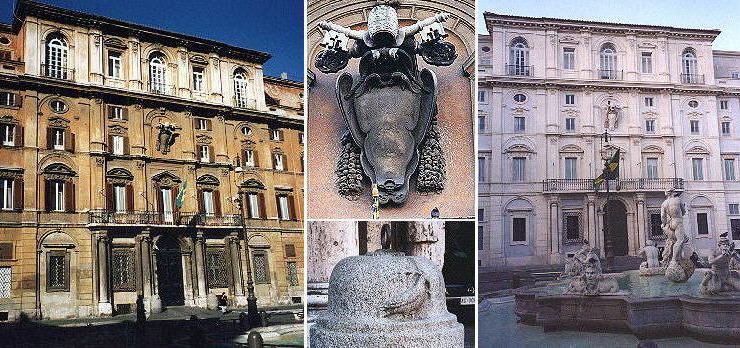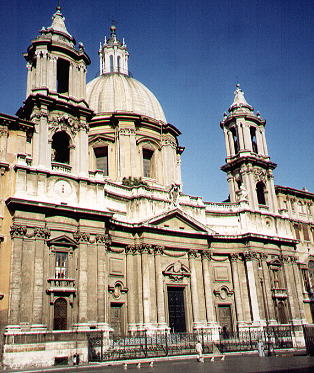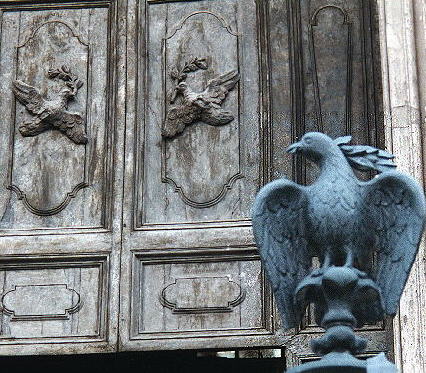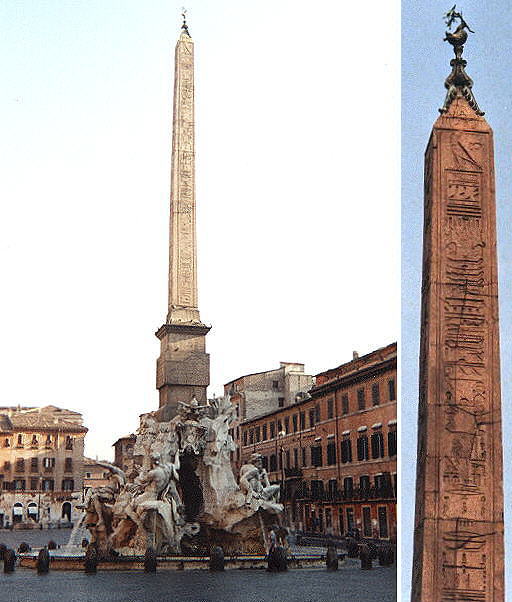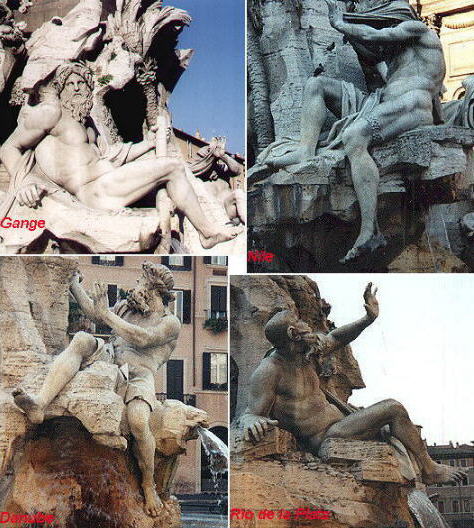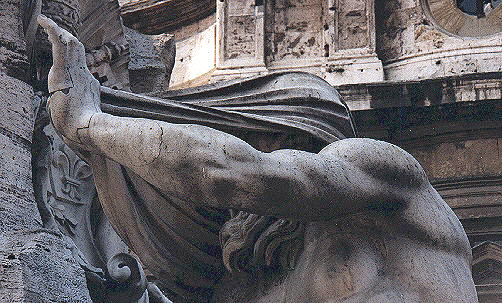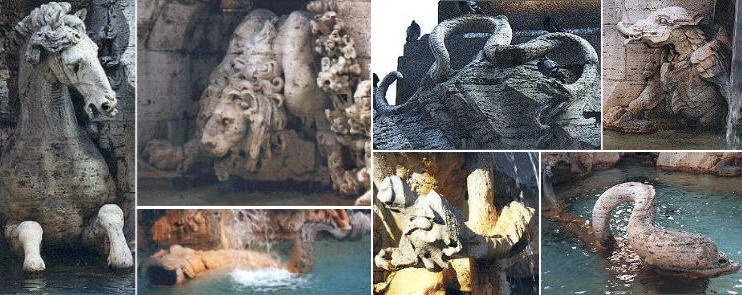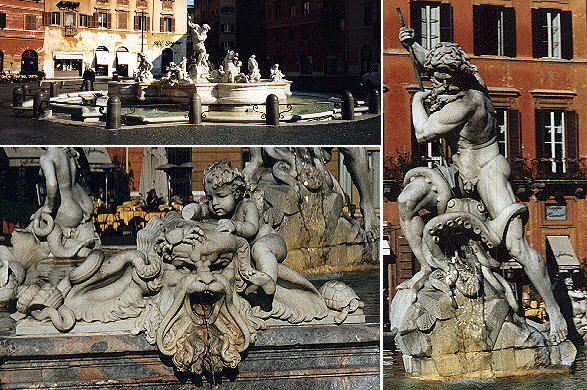

Piazza Navona (Book
2)
(Map C2) (Day 4)
(View C6) (Rione Parione)
In this page:
The plate by Giuseppe Vasi
Today's view
Fontana del Moro
Palazzo Pamphili
S. Agnese in Agone
Fontana dei Quattro Fiumi
The four rivers
The seven beasts
Fontana del Nettuno
in an added page:
S. Giacomo degli Spagnoli
Palazzo Lancellotti
The Plate (No. 26)
Vasi shows us Piazza Navona in summer when to provide some refreshment
to the Romans it was flooded (as a reminder of the times when
the Stadium of Domitianus was used for naumachias - fights between boats). The view is taken from the southern side (green dot in the map below). In the description below the plate Vasi made reference to:
1) Obelisco e Fontana (dei Quattro Fiumi); 2) Altre Fontane (Fontana del Moro e Fontana del Nettuno); 3) Chiesa di S. Agnese e Palazzo Panfili; 4) Chiesa ed Ospitale di S. Giacomo degli Spagnoli.
The small 1748 map shows also 5) Palazzo Lancellotti. 2a) is Fontana del Moro and 2b) is Fontana del Nettuno. 3a) is S. Agnese and 3b) is Palazzo Panfili.
Today
Always crowded by tourists during the day and a center of night life, Piazza
Navona was embellished at the end of XIXth century by the decoration of the third fountain
on the north side. In Piazza Navona the dove flies.
Fontana del
Moro
Bernini redesigned a previous basin by Giacomo della Porta adding
the central statue "il Moro" (the Moor), which he sculpted personally.
Palazzo Pamphili
The Palace (now the Brazilian Embassy) was built in 1650 by Girolamo
Rainaldi. As many other palaces in Rome it's been recently repainted. Here lived Olimpia Maidalchini sister-in-law of Pope Innocentius X,
whose name split and translated in Latin "olim pia" (once pious)
became a common joke to speak of an easy going woman. She convinced the Pope to name her Princess of S. Martino (see this town, totally redesigned in the XVIIth century).
S. Agnese in Agone
Previously the church was oriented in a different way: the back
towards Piazza Navona and the entrance from Via dell'Anima. Agone (agonistic) is a reference
to the races which took place in the Stadium.
The initial plan for S. Agnese was designed by Girolamo Rainaldi helped by his son Carlo. Work
started in 1652, but one year later Francesco Borromini replaced Rainaldi and modified almost entirely
the design of the fašade, which was expanded to include parts of the Pamphili palace, thus gaining
space to erect the two bell towers. Borromini designed also the dome on a high drum. In 1655
Pope Innocentius X died and soon Borromini lost the support of Prince Camillo Pamphili who
called back Carlo Rainaldi, who completed the fašade by 1666. Although Rainaldi modified
some aspects of the fašade, of the towers and of the dome the overall impression
is of consistency in style. S. Agnese represented the solution vainly pursued for St Peter's by Bernini and it
became a model for having a balance between the dome and the fašade of a church. Each of the bell towers has a clock:
this occurs also in St Peter's and in SS. TrinitÓ dei Monti. The clocks indicated two different times: the Italian time and the
European time (Tempo Ultramontano): W. J. Goethe gave a detailed description of the two
practices in his Italienische Reise - September 17, 1786 (for a short explanation see the old clock of Sutri). As usual the church has everywhere the dove
of the Pope. You can see a nice window by Borromini in my little selection of windows of Italy.
The Fountain of the Four Rivers
The fountain designed by Gian Lorenzo Bernini is surmounted by a Roman obelisk topped by the papal dove. See also the
coats of arms
and the
drawings by Juvarra. The obelisk was brought here from the Circus of Romulus. It is
a "Roman" obelisk in the sense that it celebrates the emperors Vespasian, Titus and Domitian and it was initially
erected in this area (then called Campo Marzio) before being moved by Maxentius to the circus built in honor of his son Romulus (to see all the obelisks of Rome click here). Bernini had not
been invited to submit a project for the fountain, as the Pope reproached him for his too close
connection with his predecessor Urbanus VIII and for the technical failure of his attempt to
erect St Peter's bell towers. Bernini found a way to have a model of the fountain seen by the Pope and
he immediately got the commission. The reaction of the Romans to this new fountain was not that
enthusiast according to Pasquino:
Noi volemo altro che Guglie e Fontane.
Pane volemo: pane, pane, pane!
(We need other than spires and fountains. Bread we want: bread, bread, bread).
The Rivers
Bernini involved his scholars in the execution of the fountain: Ganges (by Claudio Francese identified as Claude Adam or as Claude Poussin - two French sculptors who worked in Rome - according to
R. Wittkower), Nile (by Giacomo Antonio Fancelli), Danube (by Antonio Raggi il Lombardo),
Rio de la Plata (by Francesco Baratta) represent the four quarters
of the world (sorry for the Aussies). The rivalry between Bernini and
Borromini is usually mentioned to explain the hand of Rio de la Plata, scared
that the church built by Borromini could fall on him, and the Nile
covering his head in order not to see the church of the rival, but you
could see in these gestures also a symbol of mankind, scared and ignorant (as a matter of fact the fountain
was designed and completed before Borromini got the responsibility of completing the church).
The Beasts
Seven animals in different ways linked to the rivers populate the fountain and add life to it.
Fontana del Nettuno
The decoration of the third fountain was added only in 1878 and for once it is an addition in line with the
general context.
Excerpts from Giuseppe Vasi 1761 Itinerary related to this page:
Piazza Navona
Corrottamente si dice questa magnifica piazza navona in vece di Agonale, poichŔ quivi fu
il magnifico Circo, detto Agonale dalla parola agone, che vuol dire combattimento. Altri
hanno pensato,che tal nome derivasse dalle feste agonali dedicate a Giano, le quali si
facevano ai 9. di Gennaro. Fu ancora detta di Alessandro Severo, per la vicinanza delle
sue terme. Oltre i giuochi di delizia, e di esercizio, eranvi ancora nel circo agonale i
lupanari, cioŔ stanze sotterranee destinate per le donne di mal fare. Ora per˛ svanite
tutte quelle oscenitÓ, vi Ŕ sorta una gran piazza, cinta di nobili casamenti, e tempj,
e si dice piazza Navona, e vi si tiene in ogni settimana il mercato di ogni sorte di
viveri, e di cose domestiche, concorrendovi colle loro grascie i popoli vicini.
Nell'estare poi in ogni domenica di Agosto si fa nella medesima piazza un delizioso lago
formato dalle abbondanti fontane, che a guisa di sorgenti la riempiono di acque, e per˛
vi concorre la nobiltÓ con i loro cocchi, e la cittadinanza a farne applauso.
Quý fa nobile prospetto la
Chiesa di s. Agnese
Ove Ŕ questa magnifica chiesa furono i suddetti lupanari, in cui fu condotta la verginella
s. Agnese per ordine di Sinfronio Prefetto di Roma, acci˛ fosse violata la sua verginitÓ;
ma essendo liberata dall'Angelo suo custode, che colla sua presenza fece all'improvviso
cader morto il figliuolo del Prefetto, nel tempo, che pensava di molestarla, e poi per
li fervorosi prieghi del Prefetto medesimo, facendo ella orazione a Dio fu rimesso in vita.
Per conservare la memoria del sopraddetto celebre fatto, fu nel medesimo luogo eretta una
piccola chiesa, la quale Ŕ memorabile ancora, perchŔ essendo stata parrocchiale, fu in
essa battezzata s. Francesca Romana. Assunto poi al Pontificato Innocenzo X., che quivi
aveva la sua abitazione, eresse la magnifica chiesa con disegno del Cav. Rainaldi; ma dipoi
fu terminata col mirabile prospetto, e cupola dal Cavaliere Borromini, ed Ŕ una delle
pi¨ cospicue, e ricche chiese di Roma. E' formata questa in croce greca, e fino al
cornicione Ŕ tutta di marmi, sculture, e bassirilievi, anco negli altari; dal cornicione
in su Ŕ tutta ornata di stucchi dorati, e pitture a fresco. Il bassorilievo nell' primo
altare a destra Ŕ di Francesco Rossi; la statua di santa Agnese nelle fiamme, ed il rilievo
di s. Emerenziana nell'altro altare sono di Ercole Ferrata. Il gran rilievo della Sagra
Famiglia sull' altare maggiore Ŕ di Domenico Guidi, e quello, che siegue di s. Cecilia, e
di Antonio Raggi. La statua di s. Sebastiano nell'altra cappella l'aveva fatta il Cav. Bernini,
ma perchŔ riuscý di piccola proporzione, fu posta nella sagrestia contigua, e sull'altare
ve ne fu messa un'altra, di cui non se ne sa l'autore, ed il s. Eustachio tra le fiere, Ŕ
di Melchior Maltese, che poi fu terminato da Ercole Ferrata suddetto. Le pitture negli angoli
sono graziose opere del Baciccio, e quelle nella cupola di Ciro Ferri; ma per disavventura
morto sul principio dell'opera, essa fu terminata dal Pasqualini suo allievo. Il deposito
d'Innocenzo X., che sta sopra la porta, Ŕ del suddetto Bernini, ed il bassorilievo della
s. Vergine, che sta nel sotterraneo, Ŕ dell'Algardi.
E' unito a questa chiesa il collegio, che dicesi Panfili per li giovani vassalli di
quell' Eccma casa, ed ancora una grandiosa librerýa, per comodo de' medesimi, ed altresý
de' Preti cappellani. A destra della chiesa evvi il
Palazzo Panfili, e Collegio
Dal mentovato Innocenzo X. fu fatto questo magnifico palazzo con disegno del Borromini,
e vi sono delle pitture fresco di Pietro da Cortona. Ma non contento quel magnanimo
pontefice del palazzo, e della chiesa, volle anco incontro a questa fare l'ammirabile
fonte, e si prevalse dell'ingegno del Cav. Bernini. Questo seppe unire l'antico col
moderno, formando quattro scogli, che dopo una proporzionata altezza, unendosi con
grazia formano piedistallo all'obelisco egizio, che era stato preso dal Circo di
Caracalla il quale in segno di pace termina colla colomba, che ha un ramo di ulivo in
bocca, fatta di metallo conforme all'arme di quel Pontefice. Posano i quattro scogli
in un seno circondato di acqua, che figura il mare perci˛ vi si vedono dispersi de' pesci;
e sopra li scogli stanno a sedere i quattro Fiumi principali del Mondo, figurati in
quattro colossi di marmo; il Danubio fu scolpito da Claudio Francese;
il Gange da Francesco Baratta; il Nilo da Gio. Antonio Fancelli, e
l'Argentano da Antonio Raggi; li scogli per˛ con il cavallo, leone, palma, ed altri
ornamenti furono fatti di mano del medesimo Bernino, il quale fece ancora la bellissima
statua del Moro, posta in mezzo all'altra fontana fattavi giÓ da Gregorio XIII. i
tritoni per˛ co' delfini sono opere di fra Guglielmo della Porta, e secondo alcuni
del Buonarroti.
|
Next plate in Book 2:
Piazza di Pasquino
Next step in Day 4 itinerary:
Piazza di Pasquino
Next step in your tour of Rione Parione:
Piazza di Pasquino

Go to
 or to Book 2 or to my Home Page on Baroque Rome or to my
Home Page on Rome in the footsteps of an
XVIIIth century traveller. or to Book 2 or to my Home Page on Baroque Rome or to my
Home Page on Rome in the footsteps of an
XVIIIth century traveller.
|



 or to Book 2 or to my Home Page on Baroque Rome or to my
Home Page on Rome in the footsteps of an
XVIIIth century traveller.
or to Book 2 or to my Home Page on Baroque Rome or to my
Home Page on Rome in the footsteps of an
XVIIIth century traveller.
